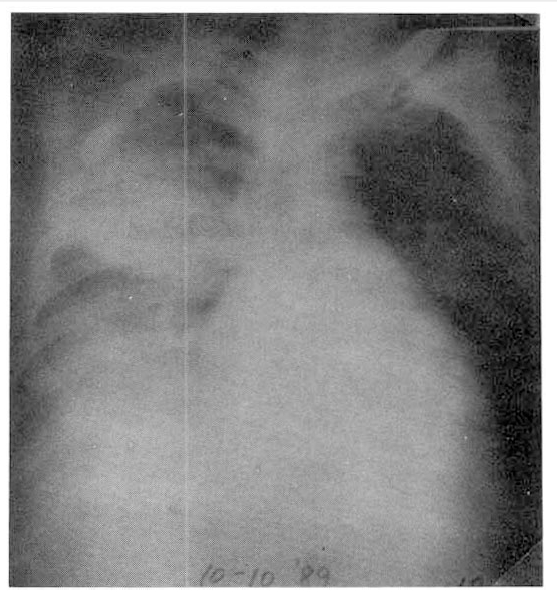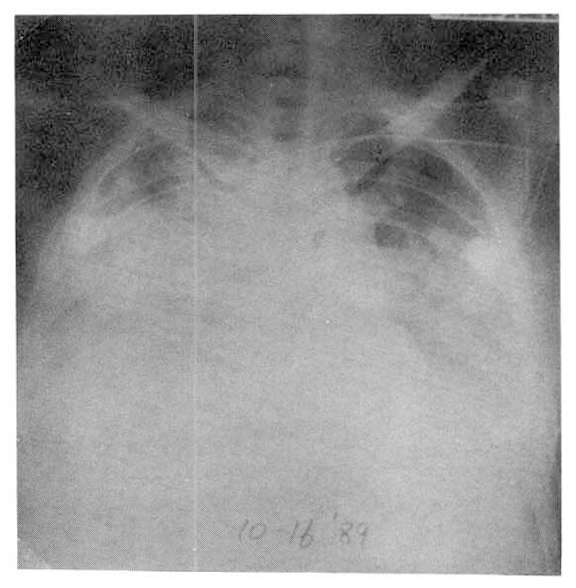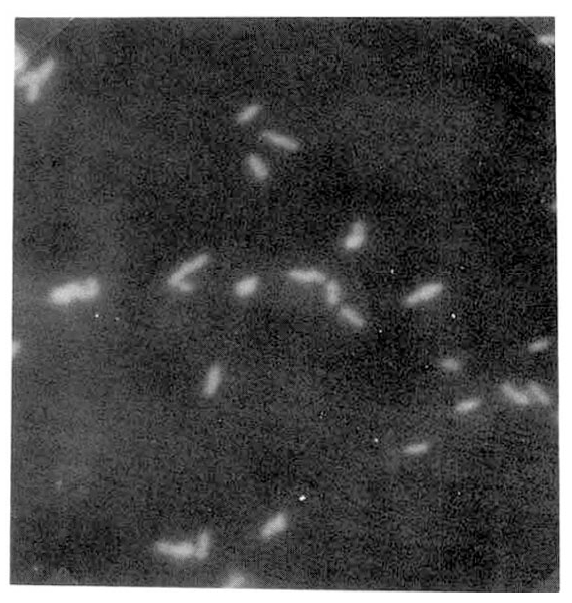 |
 |
| Korean J Intern Med > Volume 7(1); 1992 > Article |
|
Abstract
We report a case of nosocomial legionellosis in a 63 year-old man who was managed with neurosurgery under the diagnosis of subarachnoidal hemorrhage and complicated pneumonia in the intensive care unit. A legionella species was reported from sputum culture and direct immunofluorescent antibody test revealed L. pneumophila (serogroup 2). Our patientŌĆÖs pneumonia was cured with medical therapy including erythromycin and was the first case of microbiologically confirmed legionellosis in Korea.
Outbreak of Pontiac fever caused by L. gormanii in patients of intensive care units and hospital personnel was the first report of Legionellosis in Korea in 19841). Legionella species were cultured from environmental samples and there was a survey of prevalence of antibody in Koreans2,3,4). Thereafter, Korean doctors and people paid attention to the legionnariesŌĆÖ disease especially in summer months2ŌĆō5).
LegionnaireŌĆÖs disease refers to a distinct clinical entity characterized by a pneumonic illness with systemic manifestation such as high fever, gastrointestinal symptoms and encephalopathy caused by the gram-negative bacillus Legionella species (esp. pneumophila).
Although human disease due to L. Pneumophila has now been retrospectively documented by an indirect fluorescent antibody test to have occurred as long ago as 1947, clinical recognition, isolation, and identification of the bacterium resulted from the Philadelphia outbreak in July, 19766,7). Since the report of the outbreak of legionnairesŌĆÖ disease in 1976, it has emerged as a major nosocomial problem.
Epidemiologically, LegionnaireŌĆÖs disease may appear as an apparently sporadic case or in association with a recognized outbreak. Nosocomial legionellosis has now been reported throughout the world and no apparent geographic predilection has been observed6,7,8). We report the first case of culture-proven nosocomial legionellosis in a 63 year-old Korean male.
A 63 year-old man was admitted through the emergency room because of sudden loss of consciousness.
Upon admission, his blood pressure was 170/100mmHg, body temperature 37.5┬░C, pulse rate 75/min, respiratory rate 16/min and stuporous consciousness with anisocoric pupil, prompt light reflex, stiff neck. Examinations of the chest, heart, abdomen were free.
On laboratory data, leucocyte count was 52. 800/mm2, with 97% of neutrophils, 2% of lymphocytes. The hemoglobin was 18.8 g/dl, hematocrit 58.1%, platelet 480.000/mm2. Computerized tomorgraphy of the brain revealed the subarachnoid and intraventricular hemorrhage with communicating hydrocephalus.
This patient was managed with ventriculoperitoneal shunt, and supportive care such as oxygen after tracheostomy, antihypertensive agents, intracranial pressure lowering agents, anticonvulsants and fluid with electrolytes.
On the 18th hospital day, temperature rose to 38.5┬░C, difficulties in breathing developed. Chest X-ray showed hazy infiltration on right lower lung field and patch infltration in right upper lung field (Fig. 1).
Laboratory studies revealed a white blood cell count of 18.600/mm2, with 78% of neutrophils, 20% of lymphocytes. The hemoglobin level was 13.5 g/dl with a hematocrit of 39%, the platelet count was 160,000/mm2. Erythrocyte sedimentation rate was 42 mm/hr. Blood culture yielded no result. Initially, sputum was difficult to obtain. Serum protein was 7.0 gm/dl, albumin 3.2 gm/dl, ALT (GPT) 21.1 unit, APT (GOT) 8 unit, blood urea nitrogen 29 mg/dl and creatinine 0.9 mg/dl. Blood gases showed a pH of 7.495, a PaCO2 of 38.2 mmHg, and a PaO2 of 66mmHg. Under the diagnosis of bacterial pneumonia, he was treated with cephalothin and tobramycin.
Six days later, chest X-ray changed to diffuse haziness in both lung fields (Fig. 2). No microorganism was isolated on blood culture, but legionella was cultured from sputum, which was identified as L.pneumophila by direct immunofluorescent antibody test (Fig. 3).
The patientŌĆÖs pneumonia was cured by two weeks of erythromycin. For one more month, he was treated against subarachnoid hemorrhage and then discharged to his home but with a sequela of aphasia.
In Korea, Pontiac fever in ICU patients and in health care workers was the first report of nosocomial legionellosis1) and Choe et al reported a serologically confirmed case of LegionnaireŌĆÖs disease5). Hospital acquired Legionellosis may occur as sporadic cases and in outbreaks. Over 20 nosocomial outbreaks and a small number of building associated outbreaks have been reported in the U.S. and Europe. Sporadic cases likely outnumber cases associated with defined outbreaks6,7,8).
L. pneumophila is a gram-negative aerobic nonencapsulated bacilli and ubiquitously distributed. There are more than 30 species in the Legionellaceae family, with a total of more than 50 serogroups2,6). Legionella was found in water, from cooling towers, evaporative condensers, from thermal effluents and from fresh water lakes not known to be associated with disease. Legionella inoculated into water was known to survive for prolonged periods of time2,3,9,10).
The known spectrum of response to infection with L. pneumophila includes asymptomatic seroconversion, a mild self-limited febrile illness characterized by headache, chills, myalgia unassociated with pneumonia (Pontiac fever) and the severe, potentially fatal illness known as Legionnaires disease characterized by progressive pneumonia. Usual incubation period for pneumonic disease is 2 to 10 days6,7).
Legionella has accounted generally for at least 10% of nosocomial pneumonia cases. The frequency of legionella infections in the absence of outbreaks varies considerably and, in some hospitals, is very unusual despite conscientious efforts to diagnose cases. The incidence of nosocomial LegionnaireŌĆÖs disease has ranged from 1 to 40 percent, while for community-acquired pneumonia the incidence has ranged from 1 to 15 percent6,7,8,11).
Risk factors for acquisition in diverse areas are immunosuppression (particularly corticosteroids), advanced age, male sex, underlying cordiopulmonary diseases, smoking, renal failure and duration of hospitalization6,7,8). Attack rates in renal transplantation or bone marrow transplantation patents have been as high as 50% during an outbreak. Patients with hairy cell leukemia are very susceptible and AIDS patients have also contracted legionella infection12,13).
Other helpful clinical clues that might suggest consideration of the diagnosis of LegionnarieŌĆÖs disease include diarrhea, hyponatremia, larger numbers of neutrophils but few bacteria in sputum, lack of response to beta-lactam antimicrobial agents and aminoglycoside antibiotics5,6,7,8). Laboratory findings included evidence of hepaitc and renal dysfunciton. A peripheral patchy alveolar infiltration is the most common radiologic manifestation, usually involving a single lobe7,8).
Pneumonia caused by other legionella species seems to be usually clinically indistinguishable from that caused by Legionella penumophila. Simultaneous infection with L. pneumophila and other legionella species has been reported6,7).
The most reliable method of diagnosis of legionellosis is isolation of L. pneumophila from sputum on selective media9). Visualization of the organism by direct fluorescent antibody (DFA) test is the most rapid method. Indirect fluorescent antibody technic and the enzyme linked immunoabsorbent assay (ELISA) are the commonly used methods. Detection of a soluble L. pneumophila antigen in urine by ELISA, radioimmunoassay, latex agglutination may be helpful. DNA hybridization tests for Legionella ribosomal ribonucleic acid is commercially available6ŌĆō8).
Erythromycin remains the treatment of choice for legionellosis. The appropriate dose appears to be 2ŌĆō4 g daily by mouth or by vein for 3 weeks. Erythromycin is associated with low case fatality ratios and leads to prompt clinical improvement6,7,14).
We reported the first case of microbiologically confirmed legionellosis. Legionella was identified from sputum culture by direct fluorescent antibody test. Duration of hospitalization (18 days), intubation and tracheostomy for oxygen delivery, and neurosurgery seemed to be the predisposing factors in our patient.
Almost all nosocomial legionellosis cases are associated not with natural sources but with conditions that amplify and spread the organisms, including heat exchange apparatuses and distribution systems from potable water in large buildings. A definitive epidemiologic link of contaminated hospital water distribution systems was established to nosocomial cases of infection10,15,16). Contaminated aerosols probably reached the air intakes for the ventilation system. Legionellae were found in shower water and/or tap water12). No epidemiologic link has been made to showers despite intensive efforts6). Stagnation of flow of water and a reduction in hot water temperature are factors associated with the risk of transmission of legionella from potable water, or nonsterile distilled water in respiratory therapy devices15,16)
Health care workers rinse ventilation bags and mouthpieces with water. If the water is contaminated, L. pneumophila can be instilled into the lung. This may explain that nosocomial legionellosis was significantly more likely to have undergone prior endotracheal intubation15,16).
In this patient, probably the route of transmission was aspiration of contaminated water through mouthpieces and endotracheal tube. However, culture of tap water, water in the humidifier and in the respiratory therapy device was not successful.
Since the diagnosis of legionellosis requires specialized laboratory methodology, most community hospitals would not be able to document the presence of LegionnaireŌĆÖs disease even if it were present. However environmental surveillance for legionellosis is mandatory for hospitals caring for patients with immunosuppression, chronic pulmonary disease and surgery requiring general anesthesia13,16).
The optimal method for decontamination of hospital water supplies has yet to be developed. However, some methods have been widely used: hyperchlorination and/or heating of potable water and superheating plus flushing, modification of heat exchange mechanisms despite significant disadvantages17,18). Other modalities such as ozonation, instantaneous steam water heaters, ultraviolet light radiation and generation of metallic ions by electrolytes are under investigation. Since no person-to-person transmission of legionellosis has been documented, there is no need for patient isolation. If an outbreak is documented, the epidemiologic studies should be performed to determine the source, extent of outbreak and risk factors19).
A live mutant vaccine has been shown to protect guinea pigs from lethal aerosol doses of L. pneumophila. Therefore, a vaccine for high-risk patients may someday be feasible20).
Legionella pneumophila may cause the hospital-acquired pneumonia and in immunocompromised host it would become severe and fatal. Especially in intensive care units, care should be taken for the prevention of water contamination by legionella in respiratory therapy device5,17). Also, we should take legionellosis into account as one of the differential diagnosis of nosocomial pneumonia.
REFERENCES
1. Kim JS, Lee SW, Shim SH, Oh DK, Cho MK, Oh HB, Woo HJ, Chung Y. An outbreak of Legionellosis in ICU of K Hospital, Korea. Korean J Epidemiol 7:44. 1985.
2. Choi YS, Chung Y, Lee SY. Culture of legionella pneumophila and assessment of antibody prevalence. Yonsei J Med Sci 17:590. 1984.
3. Chung Y, Lee SY, Yoon JK, Choi YS, Chang IC. Isolation of Legionella from cooling tower samples. J Korean Soc Microbiol 21:107. 1986.
4. Chung Y, Lee SY, Youn JK. Prevalence of antibodies to thirteen Legionella Antigens in Koreans. Korean J Infect Dis 19:15. 1987.
5. Choe KW, Kim SM, Kim YS, Pai HJ, Woo JH, Chung Y. A case of LegionnaireŌĆÖs disease. Korean J Infect Dis 22:93. 1990.
6. Yu V. Legionella pneumophila (LegionnaireŌĆÖs disease). In: Mandell GL, ed, et al. Principles and practice of Infectious Diseases. 3 ed. 1764. New York: Churchill Livingstone, 1990.
7. Meyer RD, Edelstein PH. LegionnaireŌĆÖs disease. In: Fishman AP, ed. Pulmonary diseases and disorders. 2nd ed. 1629. New York: McGraw Hill, 1988.

8. Kirby BD, Snyder KM, Meyer RD, Feingold SM. LegionnaireŌĆÖs disease: Report of sixty-five nosocomially acquired cases and review of the literature. Medicine (Baltimore) 59:188. 1980.


9. Feeley JC, Gibson RJ, Gorman GW, Langford NC, Rasheed K, Mackel BC, Baine W. Charcoal-yeast extract agar: Primary isolation medium for legionella pneumophila. J Clin Microbiol 10:437. 1979.



10. Stout JE, Yu VL, Best M. Ecology of Legionella pneumophila within water distribution systems. Appl Environ Microbiol 49:221. 1985.



11. Fraser DW, Tsai T, Orenstein W, Parkin WE, Beecham HJ, Sharrar RG, Harris J, Mallison GF, Martin SM, McDade JE, Shepard CC, Brachman PS. LegionnaireŌĆÖs disease: description of an epidemic of pneumonia. N Engl J Med 297:1183. 1977.


12. Tobin J, Beare J, Dunill MS, Fisher-Hoch S, French M, Mitchell RG, Morris PJ, Muers MF. LegionnaireŌĆÖs disease in a transplant unit: isolation of the causative agent from shower baths. Lancet 2:118. 1980.


13. Ampel NM, Wing EJ. Legionellosis in the immunocompromised patient. Semin Respir Med 10:48. 1989.

14. Edelstein PH, Meyer RD. Susceptibility of L. pneumophila to 20 antimicrobial agents. Antimicrob Agents Chemother 18:403. 1988.



15. Murder R, Yu VL, Woo A. Mode of transmission of L. pneumophila, a critical review. Arch Intern Med 146:1607. 1986.


16. Woo AH, Yu VL, Goetz A. Potential in-hospital mode of transmission for legionella pneumophila: demonstration experiments for dissemination by showers, humidifiers and rinsing of ventilation bag apparatus. Am J Med 80:567. 1986.


17. Mastro TD, Fields BS, Breiman RF, Campbell J, Plikaytis BD, Spika JS. Nosocomial LegionnaireŌĆÖs disease and use of medication nebulizer. J Infect Dis 163:667. 1991.


18. Kuchta JM, States ST, Mc Namara AM. Susceptibility of Legionella pneumophila to chlorine in tap water. Appl Environ Mecrobiol 46:1134. 1983.

19. Yu VL, Zuravleff JJ, Gavlik L, Magnussen MH. Lack of evidence for person-to-person transmission of LegionnaireŌĆÖs disease. J Infect Dis 147:1983.

20. Blander SJ, Breiman R, Horwitz MA. A live avirulent L. pneumophila induces protective immunity against lethal aerosol challenge (Abstract). Clin Res 36:578. 1988.






 PDF Links
PDF Links PubReader
PubReader ePub Link
ePub Link Full text via DOI
Full text via DOI Download Citation
Download Citation Print
Print



